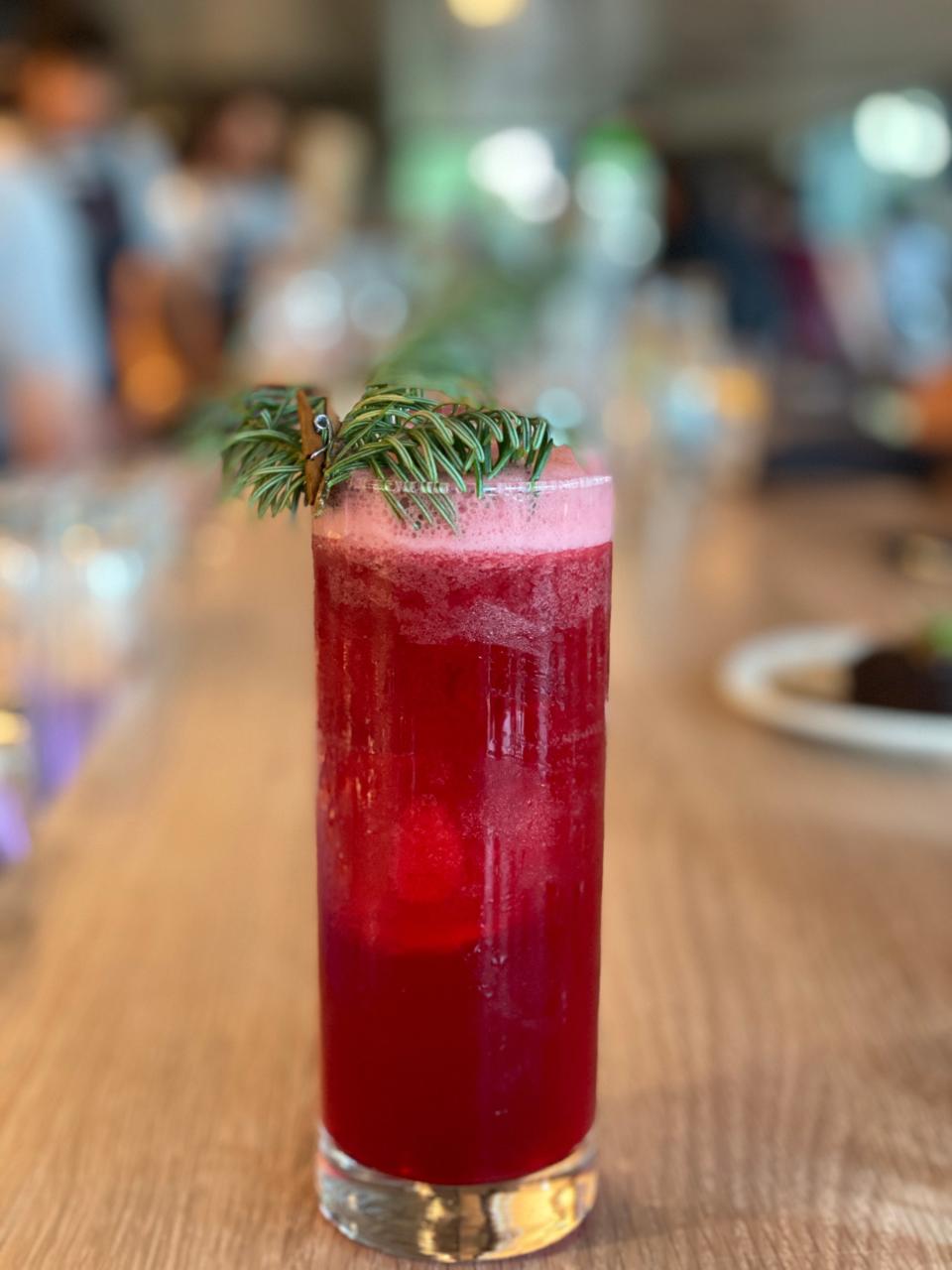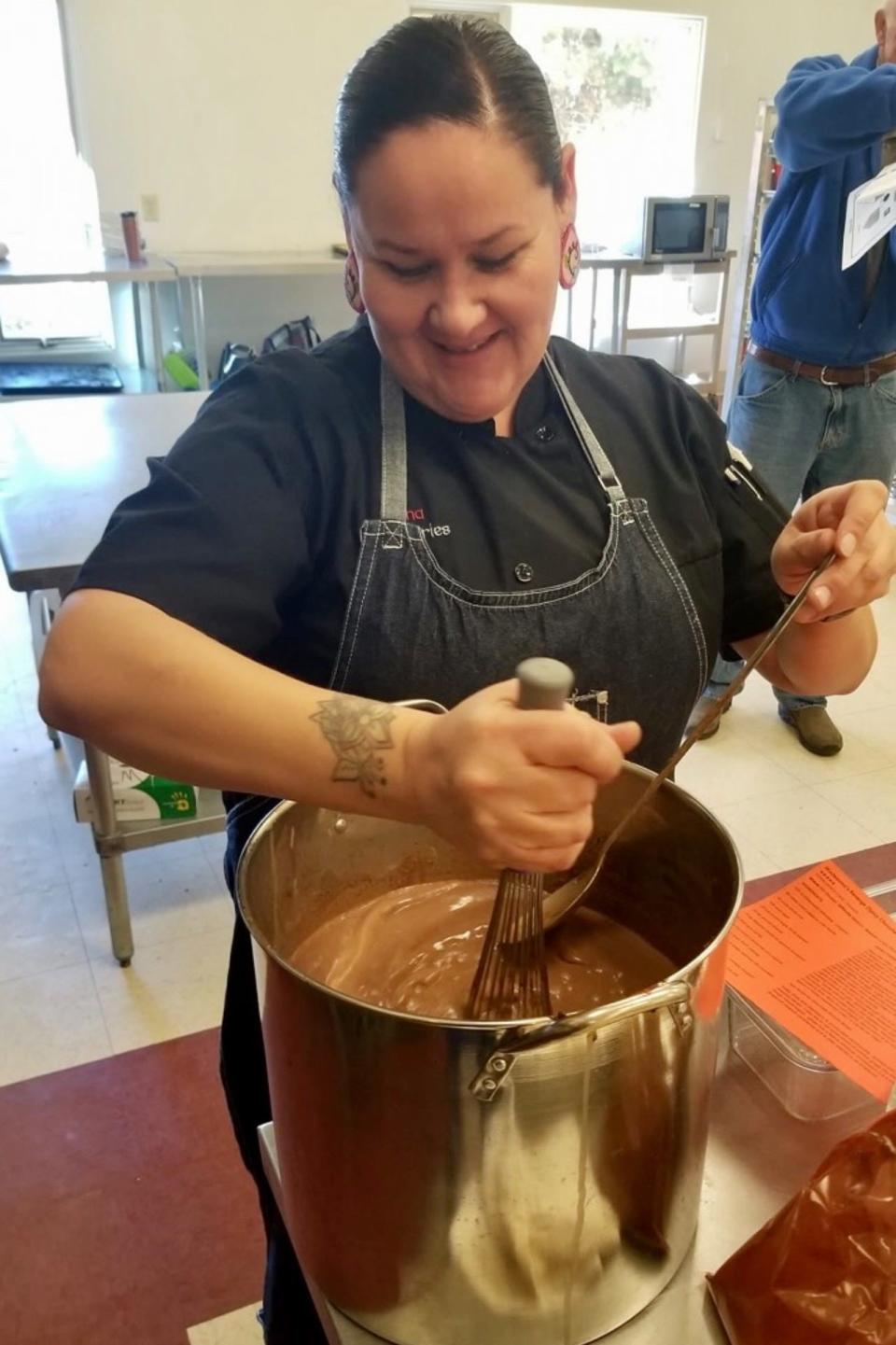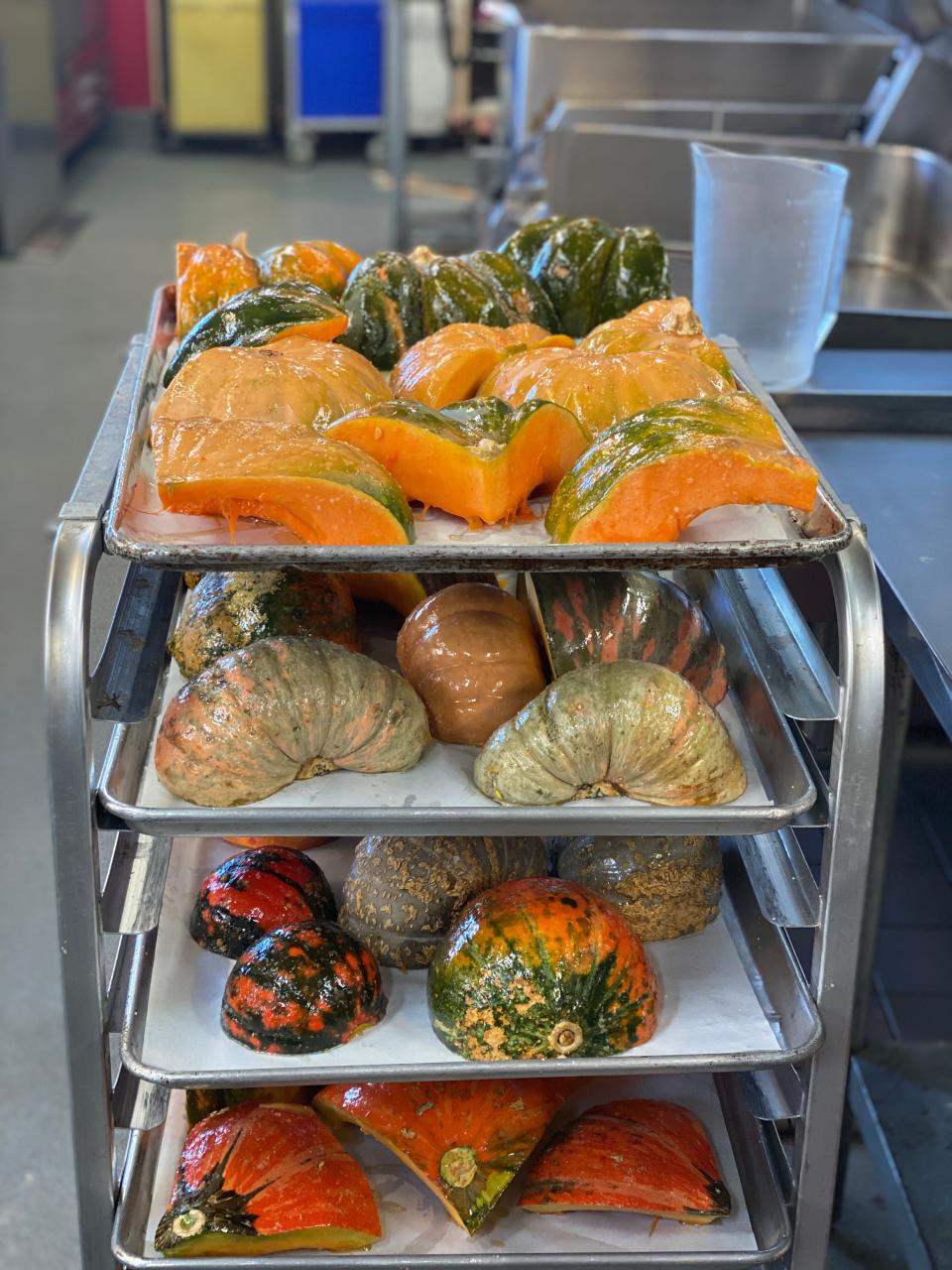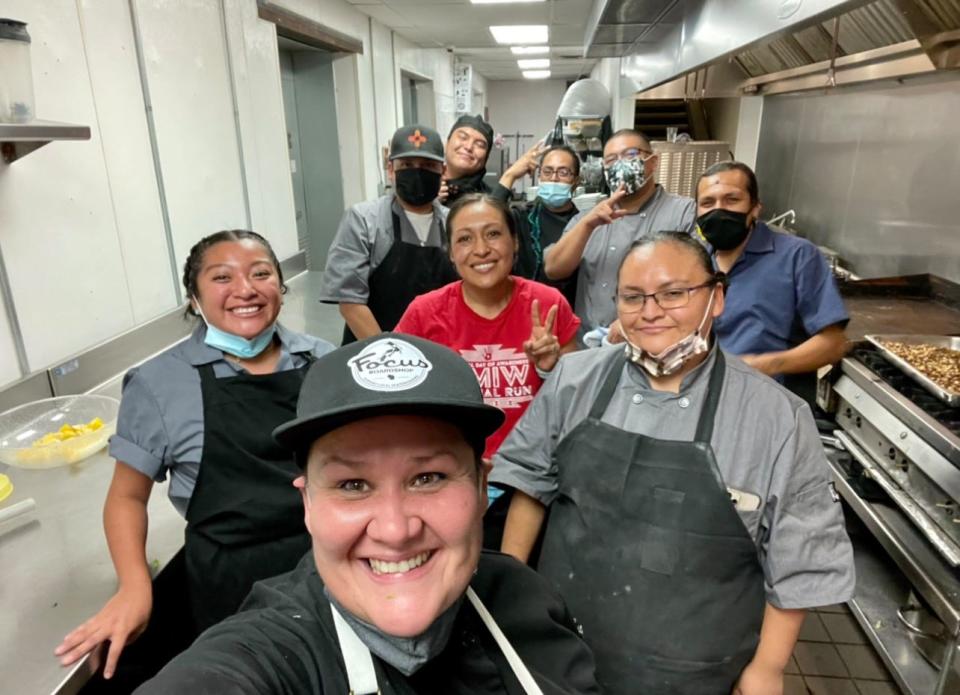Native food is more than a Thanksgiving spread. What Indigenous chefs want you to know about their incredibly diverse cuisine.
Two years ago, Elena Terry watched her daughter sing as she dug a small hole in the soil and placed a bean seed inside.
For months, Terry had searched for ancestral seeds that had been cultivated by the Ho-Chunk Nation. She contacted seed banks and libraries across the country but many of her tribe’s ancestral seeds had been lost.
Her hope was waning until a friend sent her a gift for Christmas: A seed packet from his grandfather.
“There were these tiny, beautiful seeds inside,” Terry said.
For Terry, planting the seed was reclaiming a part of her identity that was taken.
“You need resources, even if those resources are just seeds, and to plant on,” said Terry, who is the executive chef and founder of Wild Bearies, an outreach and catering nonprofit centering Native foods based in Wisconsin Dells. “And those things were stolen from us.”
As families gather for Thanksgiving, many will celebrate what Native food experts have called an oversimplified representation of Native food.
'We're very much alive': How to see America through Native travel
Support Native businesses: 15 Native-owned brands to support for Indigenous Peoples' Day

Public understanding of Native food culture is woefully limited, chefs say, and there are few Native American restaurants nationwide. Experts who spoke to USA TODAY pointed to many reasons for this but most are rooted in a history of cultural erasure and forced displacement.
"Native food is rooted in this land, in our environment and surroundings," Terry said. "Yet it's so hard to find a restaurant that serves our food."
The erasure of Native food culture
When someone says “Native American food,” Dana Thompson said she can imagine what may pop into their head: corn, a Thanksgiving spread, fry bread.
But that doesn’t scratch the surface of the “incredible diversity” of Native cuisine from nearly 600 federally recognized tribes, said Thompson, a descendent of the Mdewakanton Dakota and Wahpeton Sisseton. She also is the co-owner of the Sioux Chef, a Minneapolis-based Indigenous food nonprofit.

Native food is regional and specific to the plants and animals found in each area.
In the Pacific Northwest, Thompson said game meats, seafood and a variety of plant species are available. In the Southwest, beans, corn and cactus flowers are plentiful. Tribes in Alaska often rely on fish and fatty proteins like seal.
Native American food uses seasonal, local, sustainably harvested "ingredients that our ancestors would have foraged, grown or hunted," said Nico Albert, citizen of the Cherokee Nation and owner and executive chef of Burning Cedar Indigenous Foods.
“At its core, it's more about the source of our ingredients and the intention we use to prepare them," she said. "... We are using ingredients that are very tied to a sense of place. It's where we are and who we are. We tell that story on the plate.”
What are tribal land acknowledgments?: Native American leaders say words and actions are needed
Opinion: Building a new era of engagement between tribal nations and the federal government

When Terry thinks of Indigenous foods, she remembers building a fire outside and cooking with her great grandmother, who was known for her wild game butchery. She remembers processing turtles with her grandmothers, and weaving through tall grasses to pick milkweed before an annual picnic heralding the start of spring.
“Those are memories that I have from a young age that are just in my blood,” Terry said. “Our foods are connected to ceremony, family, places of prayer and comfort and solidarity with each other.”

But not all Native people share those memories, Terry said. Cultural erasure and forced removal of tribes from their land have severed many Native people from their food culture, she said.
Terry said her mother was a survivor of a Wisconsin Indigenous residential school, one of many federally run “boarding schools” that held Indigenous children taken from families and separated from their cultures.
“Those atrocities that happened are not far removed,” Terry said. “They are still with us. And that erasure targeted our culture, and food was one small aspect of that.”
After discovery of Canadian mass graves: Feds may investigate Native American boarding school in Nevada
Federal investigation: Chemawa Indian School families seek answers, healing
Thompson said the erasure of Native food culture was “by design" — the U.S. government “went systematically after the food systems of Indigenous people” by burning down farms, destroying food resources and removing Native people from their hunting grounds, farms and foraging areas.
It also had another effect: forcing many tribes to rely on government-issued commodity foods for survival.
Thompson grew up on these commodity foods, which were mostly unhealthy, processed and non-Native. She said this disconnect from her Native food culture from a young age affected her “in more ways than I can say.”
“Indigenous foods were almost entirely wiped off the map," she said. "... The trauma of that abuse is still with us, and it's going to take generations for us to heal that and bring that knowledge back into communities.”
History of abuse: Researchers uncover names of 102 Native Americans who died at a Nebraska boarding school

'Filling a void'
The historic exploitation of tribes left many of today's aspiring chefs and entrepreneurs without the capital needed to launch their businesses, experts said.
"Systemic, ingrained racism" also make banks less likely to invest in and offer loans to entrepreneurs of color, Albert added.
A 2016 report from the Center for Global Policy Solutions found the U.S. is losing out on over 1.1 million potential minority-owned businesses as a result of discriminatory financing practices and racial bias.
Another obstacle is that Native chefs usually want to source their food from Native growers who have “authentically Native ingredients,” Albert said. But those farms are few and far between. Getting to the point where growers can supply restaurants, rather than just their own families and communities, will require a lot of work.
“We're still in the process of rebuilding all that was taken away,” Albert said.
Despite the obstacles, Albert, a longtime restaurant manager, started her own Native catering company in Oklahoma, wanting to incorporate her favorite Cherokee food traditions — wild onion dinners, bean bread, grape dumplings and more — into her work.
Even in Oklahoma, where Native roots are more visible than other parts of the U.S., Albert said she knows of no Native restaurants.
There are also few nationwide. Colleen Vincent, vice president of community at culinary arts nonprofit the James Beard Foundation, said she knows of about 10 Native American restaurants nationwide, though she added many Native chefs may not have brick-and-mortar restaurants.
“I really do feel like I'm filling a void that has been there for hundreds of years too long,” Albert said.
In Minneapolis, The Sioux Chef opened its first restaurant, Owamni, in July to celebrate the food of the Dakota people. The nonprofit also plans to build a database of Indigenous food knowledge and help aspiring Native entrepreneurs access resources and capital.
“We're looking at rebuilding Indigenous education, rebuilding foodways, driving wealth back into tribal communities, and building them up as entrepreneurs,” Thompson said.
Evidence of genocide: In a New Mexico park, the buried bodies of Native American children
Native Americans face deadly drug crisis: How tapping into culture is helping them heal

But it can’t just be up to Native people, Albert said. Instead, “we need other people to meet us here.”
Some ways experts recommend supporting Native food efforts include advocating for food sovereignty (which emphasizes sustainable, culturally aware food practices) and investment in tribes' Native food programs and seed restoration efforts. People can buy produce from Native growers, hire Native chefs to cater events and seek out Native restaurants that do exist.

As the holidays approach, Albert recommends cooking with Native-produced ingredients or giving loved ones gifts made by tribe members.
In Terry’s daughter’s garden, a small shoot from a pole bean sprouted soon after they planted their ancestral Ho-Chunk beans. Then, a flower bloomed.
“It was the most beautiful thing,” Terry said. “It was healing and a reclamation of our connection to our food, our history, our environment. The inspiration to do this work comes from something so small but that represents so much.”
After harvesting the beans for two years, she will now have 10 seeds to grow when summer comes. When she plants them, she said she will think of her ancestors, who carried the seeds with them, even as they were forced out of their homelands.
“I have these seeds because my ancestors had hope."

Contact News Now Reporter Christine Fernando at cfernando@usatoday.com or follow her on Twitter at @christinetfern.
This article originally appeared on USA TODAY: Native American restaurants are hard to find. Chefs blame colonialism.

